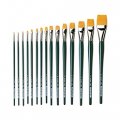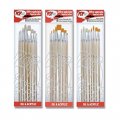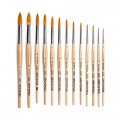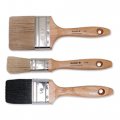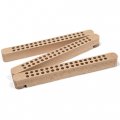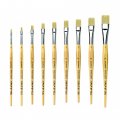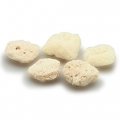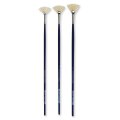Brushes
Information about brushes
Whether natural hair, bristle or synthetic fibre brush: there are many important criteria that make up a good and long-lasting paintbrush. The capability of a brush to satisfactorily fulfil its function - which is to take up paint, hold it and deliver it - is not only dependent on its type, appearance and workmanship or the origins of its hairs or bristles but also on their length (within and outside of the ferrule), the type of ferrule, the quality of the brush´s production (some are still made by hand) and, not least, on the brush´s correct care and maintenance. Please note: the word “bristles” is the general term for the filaments of any brush but can also be used to specify the hairs from hogs.
Ferrule, Binding and Gluing
High quality brushes are produced with seamless metal sleeves that are made of either drawn brass or aluminium tubes. Depending on whether a brass sleeve is nickel-plated or gold-plated, it is referred to as a “silver ferrule” or “gold ferrule”. Sheet metal or nickel ferrules with a welded seam that are used in producing basic quality brushes tend to split apart if they are left too long in water because the water can penetrate through the welding seam and cause the handle (shaft) to swell.
The bundle of hair or bristles is itself glued and then glued again into the ferrule – in the case of high quality brushes only solvent-resistant adhesives are used for these jobs. Supplementary to that gluing, the bristles are also bound in high quality brushes. For this process, the bristles are pre-formed in a brass bushing, bound with thread by hand and formed into the typical paint brush shape by twisting. The quality brush maker never ever uses a scissors or knife for shaping purposes.
The hair, bristles or synthetic filaments of the finished brush is then sized with a gum Arabic solution. This binding agent must be washed out with warm water before the brush´s first use.
Handles and size designations
A brush with a long handle is recommended for painting on an easel because it will enable a longer reach and allow the painter to stand a greater distance from the painting substrate. Brushes with shorter handles are best used when, for example, you are sitting at a table trying to achieve fine details with watercolours.
The size designations of brushes refer to the width of the brush body at the ferrule. For example, a specification of “3/0” means that the width of the brush is three times smaller than the size “0”. Brush widths and the amount of bristles in the brush are not standardized, which means that a brush from different suppliers with the given size of ”10” can in fact vary in size and have more or less filament strands.
Elasticitiy, paint intake and delivery capabilities
These attributes depend primarily on the length of the hairs or, alternatively, the bristles. The longer the treated bristles and the deeper they sit in the ferrule, the greater is their degree of resilience (which is called “snap” in artist circles). For manufacturers that pride themselves on quality a rule of thumb applies: the amount of the bristle that is invisible within the ferrule should be at least as long as the visible bristle sticking out. Only then will the body of the brush maintain its original shape without the hair or bristles fatiguing.
Additionally, the longer the hair and the greater the mico-roughness of its surface structure, the better the paint´s intake and holding capability will be. The interstices within the bundle of hairs work like capillary tubes in which the paint rises and is held until the hair or bristles are bent during the painting process and the capillaries are thereby contracted. This action presses the paint out of the capillary tubes and it then “flows”. The rough and scaly surface of natural hairs and bristles plays an important role in the delivery of the paint because it serves to more efficiently hold paint between the hairs and only deliver it a little at a time. This is where synthetic hairs are at a disadvantage, one that especially impacts watercolour painting: their smooth surface is less able to hold such thin paint than the rough natural hairs. The paint therefore flows faster and is less controllable.
Paintbrush head material: natural hairs, bristles, synthetic filaments
Biologically there is no difference between hair and bristles. Both consist of a medulla that is enveloped by squamous and cortical layers (fine scales). Technically speaking, only the stiff hairs from domestic pigs and boars are called “bristles” but in the brush manufacturing field any hair with a diameter of at least 0.2 mm counts as a bristle or, in common parlance any filament of a brush. Natural hog bristles grow conically, being thicker at the root or butt end than at the tip. The tip of each individual bristle ends in a so-called “flag”: this means that it is naturally split into two or more thin branches. This flag contributes significantly to the ability of a brush to yield a more even application without leaving grooves.
Natural hairs also grow conically but instead of ending in a “flag” they only have a more or less fine tip. The long hair from the tail of the Siberian Kolinsky (a red sable marten) represents a true novelty. This hair does not taper from the root to the tip but instead has a natural thickness in the “belly” in the middle. This “belly” is responsible for the resilience and elasticity of the red sable marten brush hairs; it must be stuck far down into the ferrule so that a Kolinsky brush can yield its unique quality of brush stroke.
Considering that natural hairs become more and more expensive every year because the demand far outstrips the supply, synthetically produced brush bristles have become every more popular as a resource-saving and economically attractive alternative. Synthetic filaments can be produced with a taper so that they, like natural hairs, can hold a needle-fine point. They have a high degree of stability and extraordinary spring tension, are easy to care for and maintain and are less expensive than natural hairs. Even though they fall short of natural hairs in their ability to take up a lot of paint and deliver it accurately, the synthetic filament brushes have proven themselves to be particularly great for painting with acrylic paints and on coarse substrates.
Kolinsky red sable hair
Kolinsky red sable hair is the most valuable and expensive hair for brush production. You might think of them as the brush equivalent of a Stradivarius. It is made from the tail hair of the Siberian red marten “mustela sibirica” (a large Siberian weasel) that mainly lives in eastern Siberian river landscapes. It is only the winter tail of the male animal that reaches the famous level of quality. Furthermore, the following rule of thumb applies: The more northern and colder the habitat, the more durable and better the quality of the long and extremely fine and tapered hair. Good Kolinsky red sable hairs are between 30 and 55 mm long and one marten tail only yields between 1 and 1.5 usable hairs that will find their way into the highest quality watercolour and oil paintbrushes. Kolinsky red marten hairs are golden red, extremely elastic and resilient (“spring”) and, when used in paintbrushes, are able to retain their shape (“snap”) even in wet conditions.
The price of a Kolinsky depends on the length of the hair used, the place of the hairs´ origin and its workmanship. In the case of truly high quality Kolinsky paintbrushes, a large portion of the hairs are stuck into the ferrule and, in addition to being glued, are also bound.
Squirrel hair
Squirrel paintbrush hairs come from the tails of Canadian and Russian squirrels and are not as resilient (less “snap”) and elastic as the red sable marten hair – but do feature an extreme capacity for holding paint. Because of this, they are often used in so-called “watercolour wash” brushes for large area painting whereby they must be able to take up a great deal of liquid. Squirrel hair is the finest of all natural hairs used in paintbrush production and can be as long as 60 mm long.
The blue squirrel and Kasan (brown) squirrel hairs represent the best quality in this group. Blue squirrel hair comes from squirrels with blue-black fur that live in Siberia, China or Mongolia. The mottled grey Kasan squirrel hair has reddish brown tips – its name comes from the Russian city of Kasan on the Wolga River.
Badger hair
Badger hair is one of the most expensive and valuable hair types in the field of paintbrush production. Because of its peculiar elasticity and firmness it is rated as being between a bristle and a natural hair. The hairs are slightly wavy and have beautiful markings that are specific to the badger, which belongs to the marten family. Its habitat is the temperate zones of Europe and Asia. Only the fully developed winter hair from the back and flanks of the animal are used for making brushes. The back hair, which can be as long as 120 mm, is primarily used for making shaving brushes and for the so-called (German) “badger blender”, a wide flat brush used for veining techniques (grain varnishing).
Pony hair
This hair, which is often mistakenly called “camel hair” comes from Chinese ponies and is used in the production of economical school brushes.
Natural bristle
The highest quality bristles used in paintbrush production come from Chinese and Russian hogs. They are distinguished by their robust structure, excellent elasticity and high degree of resilience. The high quality of the hair is a consequence of the hogs being kept in the open air, which leads to the development of a very resilient and robust bristle covering, especially in the rough climatic conditions of the Chinese highland. The white and especially robust Chungking bristles (named after the Chinese city) are used for high artist quality oil painting brushes. Bristle brushes are mostly found being used with pasty paints like acrylic and oil colours.
Care and maintenance of brushes
In order to assure the long life of a brush, particular attention should be given to a few basic principles for their use and maintenance:
- Brushes should never be stood on their bristles or hairs – always on the handle.
- Never allow remaining paint to dry in the brush. When washing, the head of the brush must be carefully rubbed and twisted in order to remove all left-over pieces of pigment at the ferrule end of the hairs. Hardened paint residue will cause the hairs or bristles to spread apart or break.
- Water soluble paints are best cleaned with running water, then smoothed out and formed back to their original shape. Natural hair brushes should occasionally be cleaned with a moisturizing CURD SOAP in order to assure the brushes will retain their elasticity for a long time.
- Acrylic paints should always be washed out with water as long as the paint is still wet. Dried paint can only be removed with special brush cleaners (see BRUSH CLEANING AND STORAGE in our shop). In the process, care should be taken that the brush never remains in the solvent for a long time because it will negatively effect the glue in the ferrule.
- Oil paint residue should first be wiped off of the brush´s head with a cloth before employing a moisturizing CURD SOAP and warm water or, alternatively, washing it out in a brush cleaning solution until it becomes clear. During the washing process, the head of the brush must be thoroughly rubbed and twisted in order to remove any pigment residue at the ferrule end of the hairs. The brush should then be wiped clean with a soft cloth and formed back to its original shape. Standing the brush for a long time in, for example, terpentine oil, is very harmful because such solutions will dry out the hairs or bristles, thereby making them brittle or even causing them to break.
- After every washing and re-shaping, the brush must be allowed to dry thoroughly. A brush should never be placed on a heater to dry it out because this can cause the handle to shrink, which will loosen the head of the brush.
